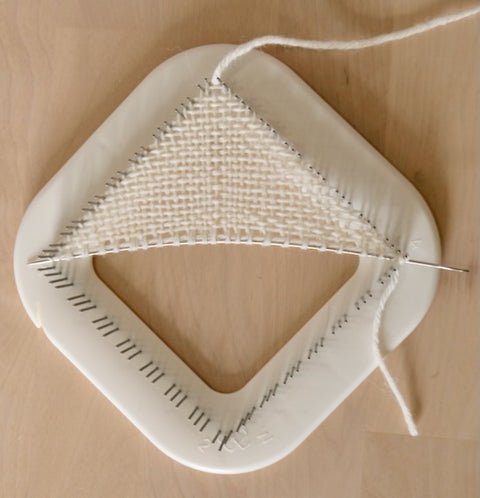Hello and welcome to the Weft Blown Blog!
I am getting back into writing blog posts and I am starting off with a post that was on the Weft Blown Cloud about how to calculate sett for weaving.
One of the most common questions I get asked is what reed do I need and how much yarn will I need for a project. My answer is usually it depends on the type of yarn (not all DK yarns are the same thickness) and what size of project you're doing.
Before we go any further the Sett is the number of warp threads per inch/cm when weaving. This is important as it determines the spacing of the warp threads which is achieved by using the reed on your loom. You need the spacing in the warp threads to allow the weft thread space to move into.
For Rigid Heddle Weaving the Sett is the size of reed you need. So if you're calculations work out that the Sett is 12 threads per inch then you need a 12 or 12.5 dpi reed. If the Sett calculations don't quite work out on reed sizes then if you go up to the next size the fabric will be slightly tighter, and if you go down a reed size the fabric will be slightly looser.
For table and floor loom weavers the Sett is the number of warp threads you will thread through the reed. It is a bit different for these looms as you can double up threads in a slot or leave spaces to get the sett you want. Sett charts like this help to work out how to thread for different setts. This does mean you can get away with one reed for a lot of setts. What I do recommend though is if you are using one sett regularly then it's a good idea to get that reed size.
Also, another important thing to do is to weave a sample and I will explain why at the end.
Anyway, the easiest way to work it all out is to do a quick bit of maths. This is easy maths, honest!
Here's what I would do:
Working out Sett
Wind the yarn you want to use for warp and weft around a ruler for 1" with the yarns sitting snugly beside each other.
Count the total number of wraps of yarn.
Then multiply the wraps by 0.5 for a plain weave cloth or 0.7 for a twill cloth (these are rough approximations and I know there are more specific ways but for basics this does work).
This gives you your sett for threading up.
Plain weave: Number of wraps of yarn over 1" X 0.5 = Sett for plain weave which is the sett for most Rigid Heddle Weaving projects
Twill weave: Number of wraps of yarn over 1" X 0.7 = Sett for Twill weave which works for most twill projects for table and floor looms
Example 40 wraps over 1" x 0.5 = 20 threads per inch for plain weave.
If you're working in centimetres you can do the same method but just over 1cm or 10cm.
Working out how many threads for width of fabric
Once you've got your Sett multiply this number by the width of warp you want.
Sett X width of warp = number of threads on warp
Example: Sett of 20 threads per inch x 10" = 200 warp threads.
Working out Warp Length
For warp length you need to take account loom waste, shrinkage/take-up and the finished length of cloth. Take-up is usually about 10% but this does depend on what yarn you're using and if the piece is going to be felted. If this is the case then sampling is your friend.
So for a 2m scarf my loom waste is usually about 30cm and the take-up is 10% of the finished length which is 20cm.
You then add all of them together to get your warp length:
Finished length of piece + Loom Waste + 10% Shrinkage = Warp Length
Example: 2m length + 30cm loom waste + 20cm take-up = 2.5m warp length
How much warp yarn is needed
Now you have the warp length you just multiply the number of warp threads in the width by the warp length.
Number of Warp Threads X Warp Length = Amount of warp yarn needed.
Example: 200 warp threads x 2.5m = 500m of yarn needed in total for the warp.
How much weft yarn is needed
The amount of weft yarn you need is usually just a little less than the warp.
So that's it really on how to work out what yarn you need and this is a rough guide which usually works for me.
As I said, I know there are more exacting calculations out there but these are good rough estimates to get you going.
I do also recommend keeping a notebook that has your calculations and you can then note down if it worked and also what the final dimensions of the piece is once it's off the loom and washed. This does help if you want to make it again as the notes are there. This is something I always do and it really does help.
Finally, I would always recommend sampling to make sure you have got the sett calculation right. This is very rich for me to say as I'm rubbish at sampling and usually always wing it. Winging it works sometimes but not always and I have rethreaded projects many time or had to work completely from scratch again. So do sample as it does save tears later :)
I hope this helps and if not and you've got more questions then do contact me.



